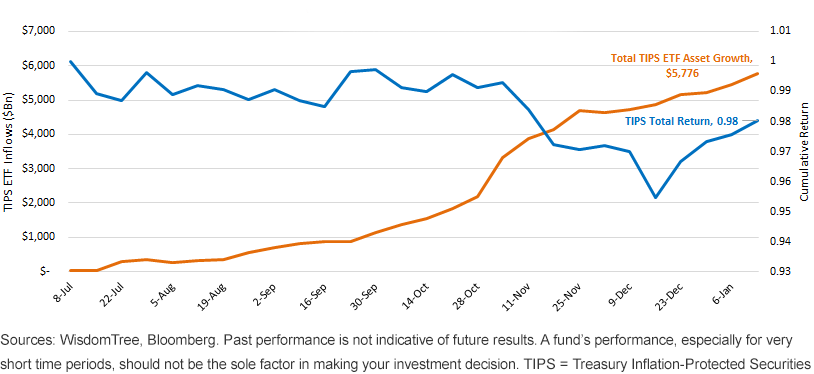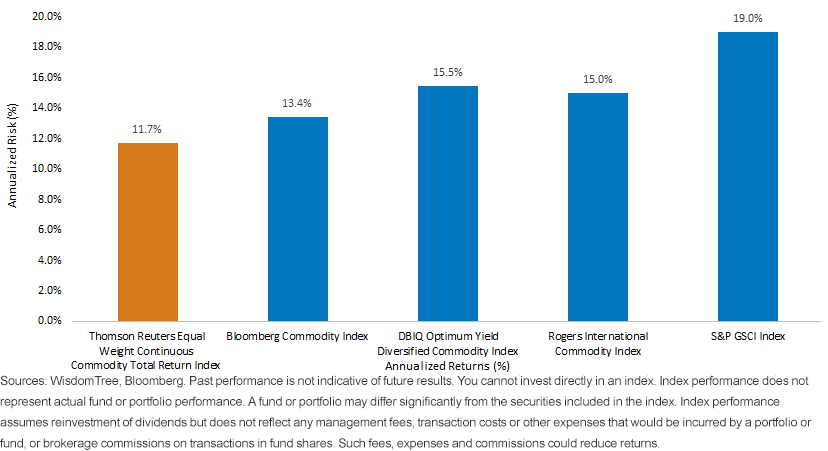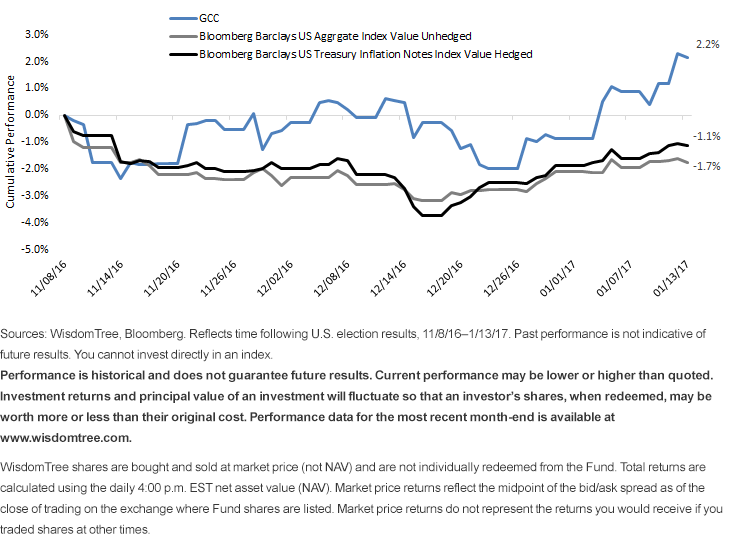A Diversified Commodities Approach For Inflation Concerns
One of the hallmarks of the newly inaugurated U.S. president’s administration is a focus on infrastructure spending. But the U.S. is not alone as a centerpiece in the global economy in its fiscal thrust. We are also getting a fiscal push from Asia. Last year, Japan embarked on a fiscal expansion program that would span four to five years and put 27 trillion yen to work. China also turned on the fiscal spigots, and we saw companies that supply construction equipment to China take a meaningful turn higher in their share prices.
Due to tightness in the U.S. labor markets, a number of investors are worried we will see inflation pressures. We have seen a surge of inflows toward U.S. inflation-protected bonds in the last six months as a result of these macro drivers.
TIPS Exchange-Traded Fund (ETF) Inflows vs. TIPS Performance (1/8/16–1/13/17)
(Click on image to enlarge)
The return on Treasury Inflation-Protected Securities (TIPS) over the last six months, despite the inflows, has been subpar, to put it mildly—though perhaps a better description is “disappointing.” These bonds have seen negative returns because in addition to increasing expectations for inflation, there was also a move higher in “real” interest rates. This caused losses on bond funds tracking these indexes. And despite the move higher in rates, the 10-Year real bond yield is still just .40%, well below longer-run averages.1
Commodities as an Alternative Inflation Hedge
If investors are flocking to TIPS for inflation protection, what are some alternative approaches that might help protect a portfolio? A principal reason investors allocate to commodities is to hedge inflation over time.
Commodities can be quite volatile, even when traded as a diversified basket, and the last five to seven years they have been one of the worst-performing asset classes, alongside emerging market equities.
WisdomTree began one of the more seasoned, diversified, and broad-based commodities strategies at the start of 2016 because, in our research and opinion, this Fund, the WisdomTree Continuous Commodity Index Fund (GCC), tracked one of the most-robust indexes, with one of the best track records for long-only commodities strategies.
Broad Commodity Exposure and Diversification
The index that GCC tracks, Thomson Reuters Equal Weight Continuous Commodity Total Return Index (CCI-TR), provides meaningful exposure to all four major commodity subgroups—energy, metals, agriculture and softs. It potentially provides better diversification than many other indexes, such as the S&P GSCI, that are over-weight in specific commodities such as energy. Plus, the index that GCC tracks rebalances daily to keep weights constant, while other commodity indexes below rebalance quarterly or annually.
Lower-Volatility Approach
CCI-TR has lower historical volatility than its commodity peer group. When compared to other commodity indexes, this lower volatility is largely attributed to a lower weighting to the volatile Energy sector. Additionally, index positions spanning the near six months of the forward curve tend to reduce volatility and mitigate negative roll yield.
5-Year Volatility–Commodity Index Landscape (12/31/11–12/31/16)
(Click on image to enlarge)
Returns since Election
The 10-Year yield has moved up about 60 basis points (bps) since Trump’s election. Real rates, offered on the TIPS bonds, initially spiked from just 10 bps before the election to a high of 70 bps in the middle of December. They have since started pedaling back down, and as of January 17th, 2017, they were at .35%. Note that the average 10-Year real rate, before 2010, was over 2.3% and since 2010 has been right around where we are today. Rising bond yields help forward-looking returns but also hurt bond portfolios. Below, you can see that both broad-based bonds and inflation-protected bonds have seen losses since the election while broad commodity strategies have shown positive returns.
(Click on image to enlarge)
Disclaimer: There are risks involved with investing, including possible loss of principal. Foreign investing involves currency, political and economic risk. Funds focusing on a single country, sector ...
more





